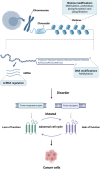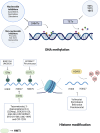Research progress and applications of epigenetic biomarkers in cancer
- PMID: 38681199
- PMCID: PMC11048075
- DOI: 10.3389/fphar.2024.1308309
Research progress and applications of epigenetic biomarkers in cancer
Abstract
Epigenetic changes are heritable changes in gene expression without changes in the nucleotide sequence of genes. Epigenetic changes play an important role in the development of cancer and in the process of malignancy metastasis. Previous studies have shown that abnormal epigenetic changes can be used as biomarkers for disease status and disease prediction. The reversibility and controllability of epigenetic modification changes also provide new strategies for early disease prevention and treatment. In addition, corresponding drug development has also reached the clinical stage. In this paper, we will discuss the recent progress and application status of tumor epigenetic biomarkers from three perspectives: DNA methylation, non-coding RNA, and histone modification, in order to provide new opportunities for additional tumor research and applications.
Keywords: DNA methylation; cancer; epigenetics; histone modification; non-coding RNA.
Copyright © 2024 Gao, Shi, Wang, Guan, Dong, Sheng, Zou, Xu, Ge, Yang, Li, Bao, Zhong and Cui.
Conflict of interest statement
The authors declare that the research was conducted in the absence of any commercial or financial relationships that could be construed as a potential conflict of interest.
Figures


Similar articles
-
Epigenomics in stress tolerance of plants under the climate change.Mol Biol Rep. 2023 Jul;50(7):6201-6216. doi: 10.1007/s11033-023-08539-6. Epub 2023 Jun 9. Mol Biol Rep. 2023. PMID: 37294468 Review.
-
Research progress of epigenetic biomarkers in the early diagnosis and treatment of human diseases.Yi Chuan. 2018 Feb 20;40(2):104-115. doi: 10.16288/j.yczz.17-220. Yi Chuan. 2018. PMID: 29428903 Review.
-
Molecular Mechanisms of Epigenetic Regulators as Activatable Targets in Cancer Theranostics.Curr Med Chem. 2019;26(8):1328-1350. doi: 10.2174/0929867324666170921101947. Curr Med Chem. 2019. PMID: 28933282 Review.
-
DNA methylation and microRNA biomarkers for noninvasive detection of gastric and colorectal cancer.Biochem Biophys Res Commun. 2014 Dec 5;455(1-2):43-57. doi: 10.1016/j.bbrc.2014.08.001. Epub 2014 Aug 13. Biochem Biophys Res Commun. 2014. PMID: 25128828 Free PMC article. Review.
-
An Update of Epigenetic Drugs for the Treatment of Cancers and Brain Diseases: A Comprehensive Review.Genes (Basel). 2023 Apr 6;14(4):873. doi: 10.3390/genes14040873. Genes (Basel). 2023. PMID: 37107631 Free PMC article. Review.
Cited by
-
Recent Advances in Anticancer Strategies.Cancers (Basel). 2025 Jan 8;17(2):173. doi: 10.3390/cancers17020173. Cancers (Basel). 2025. PMID: 39857956 Free PMC article.
-
Epigenetic Modifications as Novel Biomarkers for Diagnosis, Prognosis, and Therapeutic Targeting in Thyroid, Pancreas, and Lung Neuroendocrine Tumors.J Clin Med. 2025 Apr 11;14(8):2622. doi: 10.3390/jcm14082622. J Clin Med. 2025. PMID: 40283452 Free PMC article. Review.
-
Characterization of N6-methyladenosine long non-coding RNAs in sporadic congenital cataract and age-related cataract.Int J Ophthalmol. 2024 Nov 18;17(11):1973-1986. doi: 10.18240/ijo.2024.11.02. eCollection 2024. Int J Ophthalmol. 2024. PMID: 39559306 Free PMC article.
-
Characterization of DNA Methylation Episignatures for Radon-Induced Lung Cancer.Int J Mol Sci. 2025 Jul 17;26(14):6873. doi: 10.3390/ijms26146873. Int J Mol Sci. 2025. PMID: 40725119 Free PMC article.
-
Liquid Biopsy and Epigenetic Signatures in AML, ALL, and CNS Tumors: Diagnostic and Monitoring Perspectives.Int J Mol Sci. 2025 Aug 5;26(15):7547. doi: 10.3390/ijms26157547. Int J Mol Sci. 2025. PMID: 40806675 Free PMC article. Review.
References
-
- Abbaoui B., Telu K. H., Lucas C. R., Thomas-Ahner J. M., Schwartz S. J., Clinton S. K., et al. (2017). The impact of cruciferous vegetable isothiocyanates on histone acetylation and histone phosphorylation in bladder cancer. J. Proteomics 156, 94–103. 10.1016/j.jprot.2017.01.013 - DOI - PMC - PubMed
-
- Advani S. M., Advani P., DeSantis S. M., Brown D., VonVille H. M., Lam M., et al. (2018). Clinical, pathological, and molecular characteristics of CpG island methylator phenotype in colorectal cancer: a systematic review and meta-analysis. Transl. Oncol. 11 (5), 1188–1201. 10.1016/j.tranon.2018.07.008 - DOI - PMC - PubMed
Publication types
LinkOut - more resources
Full Text Sources

